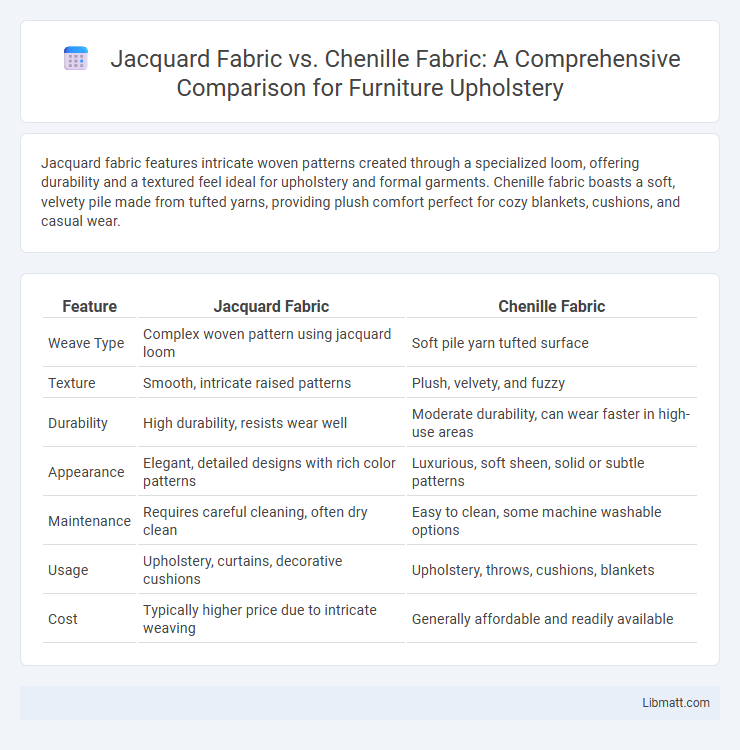Jacquard fabric features intricate woven patterns created through a specialized loom, offering durability and a textured feel ideal for upholstery and formal garments. Chenille fabric boasts a soft, velvety pile made from tufted yarns, providing plush comfort perfect for cozy blankets, cushions, and casual wear.
Table of Comparison
| Feature | Jacquard Fabric | Chenille Fabric |
|---|---|---|
| Weave Type | Complex woven pattern using jacquard loom | Soft pile yarn tufted surface |
| Texture | Smooth, intricate raised patterns | Plush, velvety, and fuzzy |
| Durability | High durability, resists wear well | Moderate durability, can wear faster in high-use areas |
| Appearance | Elegant, detailed designs with rich color patterns | Luxurious, soft sheen, solid or subtle patterns |
| Maintenance | Requires careful cleaning, often dry clean | Easy to clean, some machine washable options |
| Usage | Upholstery, curtains, decorative cushions | Upholstery, throws, cushions, blankets |
| Cost | Typically higher price due to intricate weaving | Generally affordable and readily available |
Introduction to Jacquard and Chenille Fabrics
Jacquard fabric features intricate woven patterns created through a special loom mechanism, making it ideal for decorative home textiles and fashion upholstery. Chenille fabric is characterized by its soft, fuzzy texture resembling a caterpillar, achieved by weaving tufted yarns that create a plush and cozy surface. Both fabrics serve distinct aesthetic and functional purposes, with Jacquard emphasizing detailed design complexity and Chenille focusing on tactile comfort.
Defining Jacquard Fabric: Features and History
Jacquard fabric is a highly durable textile known for its intricate woven patterns created using a jacquard loom, which allows complex designs to be woven directly into the fabric rather than printed or embroidered. Originating in the early 19th century by Joseph Marie Jacquard, this fabric revolutionized textile manufacturing with its programmable loom that automated pattern creation, making it a cornerstone in luxury upholstery and fashion industries. Your choice of jacquard fabric reflects a blend of historical craftsmanship and modern texture versatility, ideal for adding sophisticated detail to any textile project.
What is Chenille Fabric? Key Qualities and Origins
Chenille fabric, originating from the French word for "caterpillar" due to its fuzzy texture, is characterized by its soft, velvety pile made from chenille yarns twisted around a core fiber. Key qualities include its plush feel, rich texture, excellent insulation, and subtle sheen, making it popular for upholstery, throws, and cozy garments. Developed in the 18th century, chenille weaving combines durability with comfort, distinguishing it from jacquard fabric's intricate woven patterns created by jacquard looms.
Weaving Techniques: Jacquard vs Chenille
Jacquard fabric is created using a specialized Jacquard loom that controls individual warp threads to produce intricate, complex patterns directly into the weave, resulting in detailed and textured designs. Chenille fabric, however, is woven using a traditional loom and then processed by cutting and brushing the yarns to create its characteristic fuzzy, soft pile that resembles a caterpillar's texture. The weaving technique of Jacquard emphasizes pattern precision and complexity, while chenille focuses on pile construction and softness through yarn treatment post-weaving.
Texture and Appearance Comparison
Jacquard fabric features intricate, woven patterns with a slightly raised texture, offering a more structured and detailed appearance ideal for upholstery and drapery. Chenille fabric boasts a plush, velvety surface with a soft, fuzzy texture created by its tufted yarns, providing a cozy and luxurious look perfect for blankets and cushions. Both fabrics enhance interior design but differ significantly in tactile feel and visual detail, with Jacquard emphasizing pattern complexity and Chenille highlighting softness.
Durability and Maintenance Differences
Jacquard fabric is known for its durability due to its woven intricate patterns, making it resistant to wear and tear compared to chenille fabric, which has a softer, textured surface that can be more prone to snagging and pilling. Maintenance for Jacquard typically involves gentle cleaning and occasional professional care to retain its design integrity, while chenille requires more frequent vacuuming and careful handling to prevent crushing the pile and preserving its plush feel. Understanding these differences helps you choose the best fabric for your furniture or upholstery needs based on longevity and care preferences.
Common Uses in Fashion and Interior Design
Jacquard fabric is widely used in fashion for creating intricate patterns on garments such as jackets, dresses, and upholstery in interior design, adding texture and elegance to curtains and furniture. Chenille fabric, known for its soft and fuzzy texture, is commonly utilized in cozy clothing items like sweaters and scarves, as well as decorative elements in home textiles such as throw pillows and blankets. Both fabrics offer unique aesthetic qualities, with jacquard emphasizing complex weaving designs and chenille focusing on plush comfort and warmth.
Comfort and Feel: Side-by-Side Analysis
Jacquard fabric offers a smooth, intricate texture with a slightly crisp feel due to its complex woven patterns, making it ideal for decorative upholstery and formal apparel. Chenille fabric features a plush, velvety surface with a soft, fuzzy hand, enhancing comfort in casual wear and cozy home textiles. Both fabrics provide unique tactile experiences, with Jacquard emphasizing structure and design, while Chenille prioritizes warmth and softness.
Cost and Accessibility
Jacquard fabric generally comes at a higher cost due to its intricate woven patterns and complex manufacturing process, making it less accessible for budget-conscious consumers. Chenille fabric offers a more affordable option with a softer texture but may lack the detailed designs found in Jacquard. Your choice depends on balancing the expense with availability and the desired fabric aesthetic.
Choosing Between Jacquard and Chenille: Which is Best for You?
Jacquard fabric offers intricate woven patterns that provide durability and a luxurious texture, making it ideal for upholstery and decorative purposes. Chenille fabric features a soft, fuzzy surface with excellent warmth and comfort, perfect for cozy throws and cushions. Your choice depends on whether you prioritize ornamental design and strength (Jacquard) or softness and plush feel (Chenille) for your home decor needs.
Jacquard fabric vs chenille fabric Infographic

 libmatt.com
libmatt.com